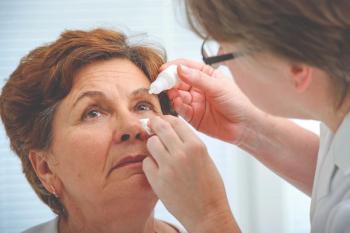
- Optometry Times October 2019
- Volume 11
- Issue 10
Epi-on cross-linking may speed visual recovery
Phase III clinical trial examines new ways to succeed with transepithelial procedure
Our practice has been performing epi-off corneal collagen cross-linking (CXL) since it was approved by the U.S. Food & Drug Administration (FDA) for patients with progressive keratoconus or ectasia.
This has been such an exciting procedure for us to offer. For the first time, eyecare practitioners have been able to provide a treatment that can slow or halt the progression of ectatic disease rather than just managing it until patients get to the point of needing a corneal transplant.
I have also seen a number of patients treated early in the disease course who have continued to be successful in glasses or soft contact lenses without being dependent on specialty contact lens fits.
Related:
Despite these positive outcomes, there are potential improvements over the way the procedure is currently performed.
Because the surgeon creates a large epithelial defect, the first few days after the procedure can be uncomfortable for patients, and it can take several days for the epithelium to heal. Until the epithelium heals, the eye is more vulnerable to haze or infection, although the risk of these complications is low.1,2
Many people think transepithelial or “epi-on” CXL has the potential to speed visual recovery and improve the patient experience.
Related:
A challenging proposition
The challenge with epi-on, of course, is that the epithelium is specifically designed to protect the eye. An intact epithelium makes adequate penetration of the riboflavin into the stroma more difficult, the epithelium may absorb ultraviolet (UV) rays before they reach the stroma.
Additionally, while the chemical reaction that takes place during cross-linking is dependent on oxygen, it also rapidly depletes stromal oxygen, which can make it less effective.
For these reasons, research of epi-on procedures have shown them to be less effective than epi-off.3
Researchers and clinicians have used several strategies to try to overcome the barriers to success with epi-on CXL.
One approach, for example, has been to add components to the riboflavin to enhance penetration.
Currently, several new riboflavin formulations for epi-on CXL are under investigation, including one that uses nanotechnology and sustained-release riboflavin.4-7Related:
In Europe, SOOFT Italia has been marketing an iontophoresis CXL (I-CXL) device that uses a positive electrical charge to help negatively-charged riboflavin solution penetrate into the stroma. A recent report on three-year follow-up in pediatric eyes found that I-CXL was less effective than standard epi-off CXL.8
It has been suggested that pulsing, or cycling the UV light off and on during treatment, could be beneficial because it allows oxygen to replenish during the “off” cycles. However, the latest data suggests that pulsing on its own does not restore enough oxygen to match the efficacy of epi-off.9
Supplementing the corneal environment with a higher concentration of oxygen has also been proposed as a way to promote greater efficacy.
Research with animal eyes has shown that specialized oxygen goggles can increase the amount of oxygen available in the stroma10 and that eyes treated with a protocol that includes supplemental oxygen had more corneal collagen stiffening than those treated with a room-air protocol.4Related:
U.S. clinical trial
Our practice is participating in a randomized, controlled Phase III clinical trial for epi-on CXL. The study, which is being conducted at 14 clinical sites around the U.S., incorporates a number of the approaches discussed above into the treatment protocol.
To be enrolled, patients must have documented progression of keratoconus, corneal thickness >325µm, and Kmax >47 D. Patients are randomized to epi-on CXL or a sham treatment; those in the sham group are eligible for treatment after 6 months of follow-up.
A new two-part riboflavin formulation, which includes a higher concentration of riboflavin, is used. The light source is a high intensity, pulsed, 30mW/cm2 365-nm UVA light.
The overall procedure is also faster than an epi-off procedure.
Related:
Additionally, specially designed oxygen-delivery goggles, which are open in the front, are placed over the patient’s eyes after instilling riboflavin drops. When sensors in the goggles indicate that oxygen concentration on the corneal surface is >90 percent, UV irradiation can begin.
Enrollment of all 275 patients in the multicenter study has been completed. We and other study centers are conducting follow-up visits, after which the data will be analyzed with the intention to present to the FDA as a drug/device combination treatment.
This is an important step to evaluate the safety and efficacy of epi-on CXL. Currently, epi-off CXL with FDA-approved solutions and device is a covered service for more than 95 percent of patients insured by commercial health plans in the U.S., but epi-on CXL can be performed only as part of a clinical trial.
We hope this technique will prove to be beneficial for patients. We are looking forward to seeing the final safety and efficacy data gathered from all centers participating in the trial.
Related:
Comanaging care
Cross-linking is a great procedure for optometrists and cornea surgical practices to comanage because patients need both our services.
Although CXL can lead to some changes in refraction, patients will still need to continue in some form of vision correction after the procedure and will need to be monitored at least annually to ensure that there is no more progression.
Postoperatively, comanaging optometrists can expect to see their patients back around the one-month mark. At this time, as long as the epithelium is fully healed, patients can also start wearing their previous contact lens prescription again.
Related:
However, the contact lens may ultimately need to be refit because the cornea changes postoperatively.
Because this procedure is an opportunity to preserve vision in these patients, I strongly encourage optometrists to watch for rapid prescription changes and high or rapidly changing astigmatism, particularly in young patients.
For those optometrists who don’t have topography to help confirm a keratoconus diagnosis, it is a good idea to refer keratoconus suspects to another doctor for topography. When needed, they can be referred to a cornea practice for CXL, either epi-off, or in the future possibly an epi-on procedure.
References:
1. O’Brart DPS. Corneal collagen crosslinking for corneal ectasias: A review. Eur J Ophthalmol. 2017;27(3):253-69.
2. Hersh PS, Stulting RD, Muller D, et al; U.S. Crosslinking Study Group. United States multicenter clinical trial of corneal collagen crosslinking for keratoconus treatment. Ophthalmology. 2017; 124(9):1259-70.
3. Kobashi H, Rong SS, Ciolino JB. Transepithelial versus epithelium-off corneal crosslinking for corneal ectasia. J Cataract Refract Surg. 2018;44:12:1507-16.
4. Hill J, Liu C, Deardorff P, et al. Biomechanical impact of drug formulation, supplemental oxygen, and UV delivery on epi-on CXL. Presentation at Association for Research in Vision & Ophthalmology, April 27-May 2, 2019, Vancouver, British Columbia, Canada.
5. Ostacolo C, Caruso C, Tronino D, et al. Enhancement of corneal permeation of riboflavin-5’-phosphate through vitamin E TPGS: A promising approach in corneal trans-epithelial cross linking treatment. Int J Pharm. 2013;440:148-53.
6. Stulting RD, Trattler WB, Woolfson JM, et al. Corneal crosslinking without epithelial removal. J Cataract Refract Surg. 2018;44:1363-70
7. Rubinfeld RS, Caruso C, Ostacolo C. Corneal cross-linking: The science beyond the myths and misconceptions. Cornea. 2019;38(6):780-90.
8. Buzzonetti L, Petrocelli G, Valente P, et al. Iontophoretic transepithelial collagen cross-linking versus epithelium-off collagen cross-linking in pediatric patients: 3-year follow-up. Cornea. 2019;38(7):859-63.
9. Sun L, Li M, Zhang X, et al. Transepithelial accelerated corneal collagen cross-linking with higher oxygen availability for keratoconus: 1-year results. Int Ophthalmol. 2018;38(6):2509-17.
10. Hill J, Liu C, Deardorff P, et al. Stromal oxygen dynamics during high-irradiance epi-on corneal crosslinking. Presentation at Association for Research in Vision & Ophthalmology, April 27-May 2, 2019, Vancouver, British Columbia, Canada.
Articles in this issue
about 6 years ago
Lyme disease: The 45-year silent epidemicabout 6 years ago
30 years of LASIKabout 6 years ago
More than a yellow lesion?about 6 years ago
Go beyond medical treatment for recurrent corneal erosionabout 6 years ago
Toxoplasmosis shows varied diagnosisabout 6 years ago
Nutrition in the future of primary-care optometryabout 6 years ago
Artificial intelligence might be the future of practice managementabout 6 years ago
Why taking patient history never endsabout 6 years ago
Dry eye signs may signal risk for diabetic foot ulcersabout 6 years ago
Q&A: Academia, contact lenses, beer, climbing a water towerNewsletter
Want more insights like this? Subscribe to Optometry Times and get clinical pearls and practice tips delivered straight to your inbox.



















































.png)


